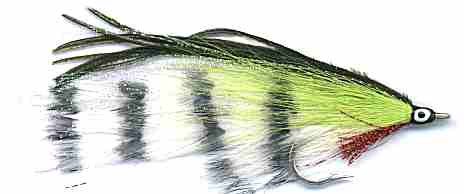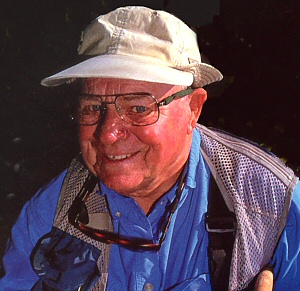Barred White & Chartreuse Lefty's Deceiver Saltwater fly
The sea hatches few insects. Saltwater flies like the Barred White & Chartreuse Lefty's Deceiver represent baitfish. Other types of saltwater flies imitate crustaceans like shrimp, lobster or crabs.

Lefty's Deceiver Saltwater Fly Hook size 2/0, 4, 6 - $US each
These bait fish range from one inch (2.5cm) to over a foot in length (30cm). You have to offer the fish something that makes it feel it is worth chasing. A big sailfish is not going to eat a small fly you would use to catch a bonefish. A large meal for a kitten is a titbit for a lion. Try offering flies that are reasonably good imitations of local food first. If that does not work then try to stimulate an attack with a brightly colored attractor pattern. There are times when a brightly colored fly that looks like nothing on earth brings results.
A Lefty's Deceiver is ideal for Bluefish and Striped bass fishing. Striped bass can be found in many costal waters from the St Lawrence River south to Northern Florida on America's Eastern Coast and from Washington to California on the Pacific Coast where they were introduced in the 1879. They swim far upstream in rivers to spawn. The stripped bass can be distinguished from the European Bass by the seven to eight dark strips running down its body. Stripers spend the winter semi dormant in river systems like the Hudson and Chesapeake Bay on the Atlantic Coast but when the sea temperature reaches 48 degrees F in the spring they become active and start to feed. The shoals migrate north up the coast and return in September/October. Big fish are caught deep in early winter, but in warmer places like Jamaica Bay they are still caught near the surface. In warm waters they can be fished for all year on the fly. They can feed in the roughest surf. You can see them chasing smaller bait fish along the beach until their backs come out of the water. You will also find them holding in estuaries, deep channels, and off jetties, piers or sand bars.

Lefty Kreh designer of the Lefty's Deceiver saltwater flyfishing streamer fly
Bass feed by trapping bait fish against a shoreline or by attacking them from deep below. Small fish are inhaled and larger bait fish are are grabbed head first and crushed. Stripers have a dangerous spiky dorsal fins so handle them by their lower lip. Stripped bass can grow up to 70lb. A bluefish feeding melee can bring up the bigger stripped bass
Stripers can be temperamental compared to the Bluefish who are an aggressive formidable predator that have a full set of sharp teeth. They are found in the same habitat as stripers. The bass normally can be found feeding on Bluefish leftovers of dead and dying fish after a feeding frenzy. If you are lucky you might witness one of these feeding blitz. They corral a shoal of baitfish into a big ball and then when the ball is surrounded they attack.
I was lucky to witness this on my last trip to the States last September. I was fishing for stripers when all of a sudden the captain pointed to gulls swarming around an area of water that was turning white with fish breaking through the surface. 'Bass?' I asked him. 'No those are Bluefish on the feed, change your tippet for wire. Those things have very fast teeth'. I used a floating line with a chartreuse and white 2/0 Lefty's Deceiver attached to the wire tippet. The gulls must have thought Christmas had come early. They were eating as many fleeing bait fish as they could swallow. The noise was very, very loud
We were told to cast into the center of the swirling mass of activity. I hooked almost immediately. Blue fish are very strong powerful fish. My first was a seven pounder and my second a 12 pounder. The Captain shouted at me to be very careful and use big pliers to extract the hook or end up in hospital with bluefish bite wounds. I must have caught over 12 of about the same size range that day. I had a fantastic days fishing. Later in the bar I found out that many of the locals looked down on bluefish as easy prey. I'm sorry I think they are a wonderful sporting fish.
Two important prey species on all three US coast lines to both inshore and off shore predators are mullet and mackerel. Mullet are blue to green along their back and silver underneath. A blue or green lefty’s Deceiver is a fantastic match for this bait fish. Our Barred Blue or Green Lefty’s Deceiver is great for matching schools of Mackerel. As they have wavy vertical bars coming down from their blue green colored back and over their silvery white stomachs. The white Lefty’s Deceiver is ideal for imitating small Herring (Other common names for similar fish from the same family include pilchard, scaled sardines, bunker, green back, pogy and menhaden) and shad.
Pike fishing with a large Lefty's Deciever
I find pike can grow weary seeing the same fly fishing pattern again and again. I therefore go armed with a variety of large hook patterns in different sizes and colours. They see a lot of white flies: they get a lot of follows but not many hits. I like black flies for catching pike but it is a colour that few pike anglers seem to use. A large black or Viva Woolly bugger works well. I have had success in cloudy water using a black and red Seaducer who’s hackle is designed to send out vibrations through the water on the retrieve.
My favourite fly for subsurface pike fishing is the lefty’s deceiver. When wet they resemble bait fish and the long fibres move life like on the retrieve. I have found that the normal rules for reservoir trout fishing dos not normally work for pike hunters.
Pike growing fat on a high-protein diet of trout and other coarse fish do not need to ambush anything. So avoid all those popular places like reed beds, incoming rivers, overhanging trees and sunken tree roots. I prefer to fish features such as old river beds, sudden drop-offs from shallow to deep water and weedbeds. You can catch jacks (young pike) near structures like reed beds but the biggest pike like to spend most of their time in quite, seemingly featureless water. When their stomach rumbles with hunger pains they change gear and search out their next meal, returning to their favoured quiet space to digest the meal they just devoured.
All my pike fishing is done on the drift, never at anchor regardless of the strength of the wind. I find that pike wise up very quickly to the presence of a boat and anglers so constantly casting to the same location becomes unproductive. Once a pike has seen and followed a fly I feel it is unlikely to go in for the attack twice. For this reason I vary my drifts all day, never immediately repeating a drift, even if successful. You can go back again an hour or two later with a different type of fly pattern.
I believe the eyes and red gill fibres give the pike an aiming point and are critical in the success of the Lefty’s Deceiver fly pattern in salt water and in fresh water lakes or reservoirs. As pike on the fly becomes more popular I like to take a break and watch the tactics of other practitioners.
The one thing they all seem to like using is a fast, stripped retrieve. I accept at times the pike like this style of retrieve but for the vast majority of my successful takes ere a result of using a simple figure of eight, just as if I was nymphing for trout. You need to develop your ability to cast big flies a long distance. Practice on the grass in a local park or field to perfect your fly lobbing abilities. It will pay off when you are on the water.
The first thing I do when my lefty’s deceiver hits its target area is pull several feet of flyline to straighten everything and gain control of my fly. This is critical as a pike might take your fly on the drop. If nothing immediately takes your fly then start I let it sink for a few seconds. I vary this time period to search different depths. On the first cast I normally wait 5 seconds. On the second cast I wait 10 seconds and on the third cast 15 seconds and so on until you hit bottom.
My figure of eight varies from dead slow to an erratic jerky fast action. All these retrieves can work. Just experiment until you do something that makes a pike attack your fly. Do not strike immediately. Just keep the retrieve going until everything locks up. Pike tend to suck or engulf a fly rather than attack it. You will often feel a pull and then the line goes slack. When this happens the pike is actually swimming towards you with the fly in its mouth but has not yet fully closed its jaws.
Sometimes the takes are savage and the pike hooks themselves but most takes only announce themselves when the line feels heavy. It is at this point that I normally give the flyline a sharp pull. If the pike has taken the fly you will feel resistance. I then use strip striking to set the hook. On no account should you raise the rod tip and trout like a trout fisherman. That is one of the best ways of pulling a fly straight out of a pikes mouth.

CUSTOMER'S PHOTO - BARRAMUNDI FLY FISHING
Greeting from Asia, Malaysia. For your information, my country do have dry flies
targeting fish such as trout and salmon. Mostly, fly fishermen in my country are
using wet flies to catch barra, giant snakehead, king fish and M.J. The
enclosed photos shown 1 out of the 3 barramundi that I caught
yesterday by used your Lefty's Deceiver salwater flies. Thank you. Admund
Malaysia
CUSTOMER'S COMMENT
Your flies fish Great! I have caught a lot of seatrout on the Lefty's Deceiver in Norway fjords. I would like to order some more of them. Alex Ekberg, Kristiansand, Norway
CUSTOMER'S COMMENT
I went on a fishing trip to Tobago during March. The Blue and White Lefty's Deceiver turned out to be the winning fly for both Tarpon and Jack Cravelle. Fredrik Forsberg from Sweden
CUSTOMER'S COMMENT
A White and Chartreuse Lefty's works great in the early part of the season on the Little Miami River South of Dayton in Ohio. - Stan Cooper


Lefty's fishing books

